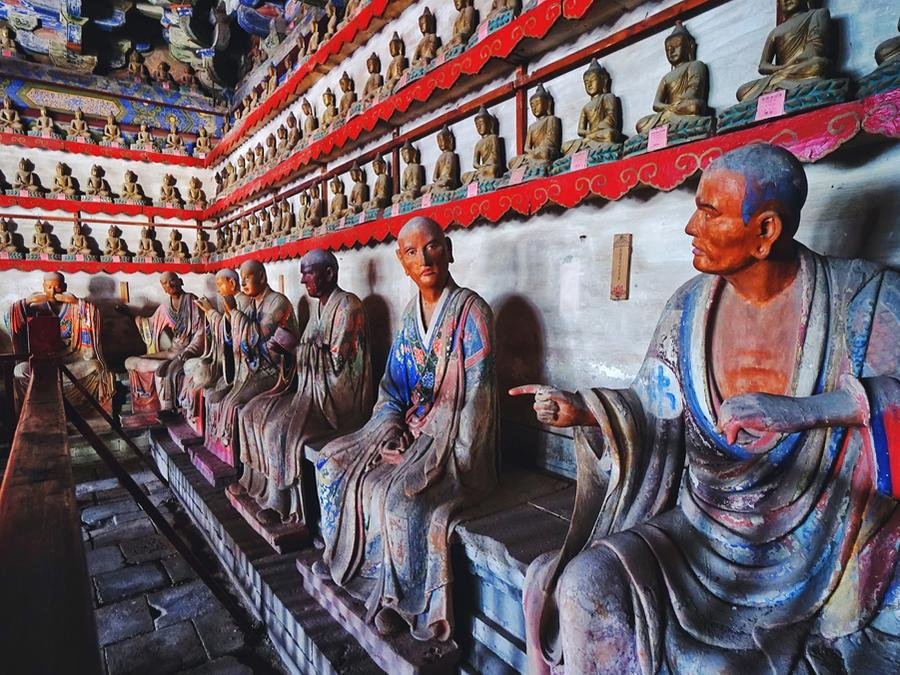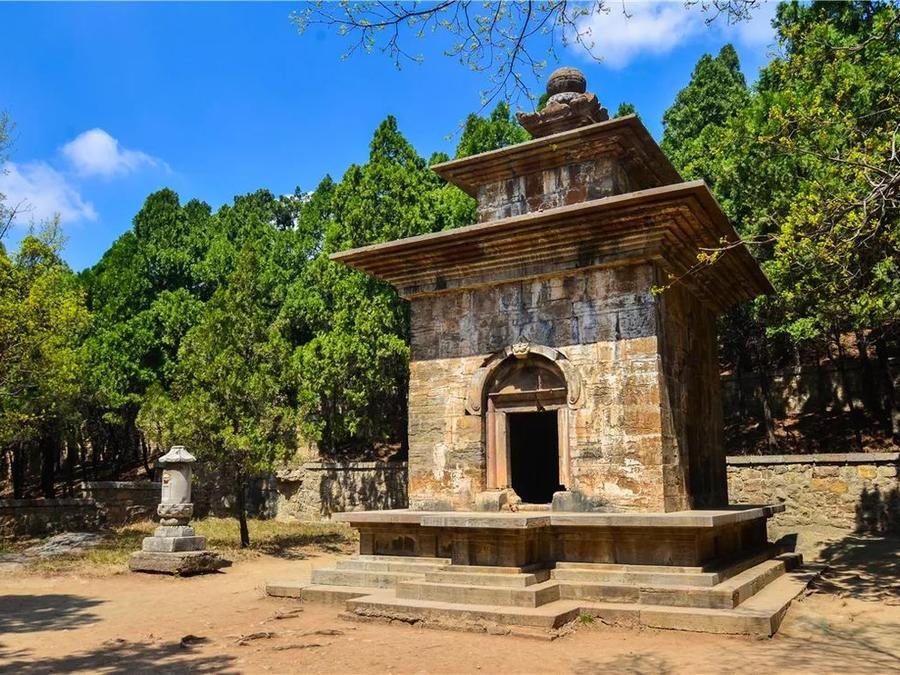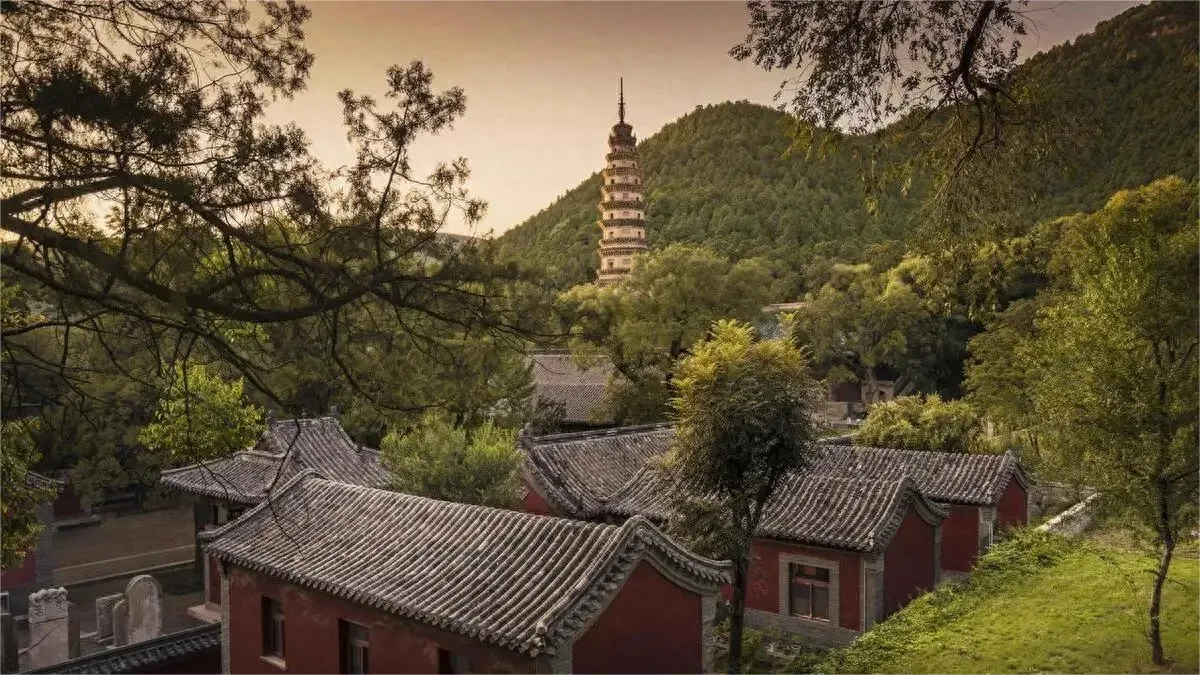Lingyan Temple (灵岩寺), with a history spanning over 1600 years, was initially built during the Eastern Jin Dynasty. Its reconstruction began in the first year of Emperor Xiaoming of the Northern Wei Dynasty and reached its zenith during the Tang Dynasty. At its peak, the temple complex boasted over 40 halls and pavilions, more than 500 meditation rooms, and housed over 500 monks. Renowned for its profound Buddhist heritage, Lingyan Temple has been historically revered alongside Nanjing’s Qixia Temple, Zhejiang’s Tiantai Guoqing Temple, and Hubei’s Yuquan Temple as one of China’s “Four Famous Buddhist Temples.”
During the Tang Dynasty, the eminent monk Xuanzang resided at Lingyan Temple to translate Buddhist scriptures, and successive emperors from the Tang Dynasty onwards visited the temple during their imperial pilgrimages to Mount Tai.
Located amidst picturesque mountains with steep cliffs, Lingyan Temple is adorned with ancient cypress and fragrant tea springs. The temple grounds are rich with historical relics such as the towering Pizhi Pagoda and the legendary Iron Kasaya. Architectural marvels from the Sui and Tang Dynasties, like the Banzhou Hall, and Song Dynasty colored clay sculptures of Arhats, add to its cultural significance.
Table of Contents
- Basic Information
- Location and Transportation
- Map of Lingyan Temple
- Highlights of Lingyan Temple
- Other Attractions in Mount Tai Area
Basic Information
| Estimated Length of Tour | 2 hours |
| Ticket Price | 40 RMB |
| Opening Hours | 8.30 – 17.00; Last admission: 16.30 |
| Telephone Number | 0086-0531-87468073 0086-0531-87468099 |
Location and Transportation
Lingyan Temple is located in Wandao Street, Changqing District, Jinan City, Shandong Province, northwest of Mount Tai. To get there, you can take bus 796 and get off at Lingyan Temple Stop (灵岩寺站).
Map of Lingyan Temple

Highlights of Lingyan Temple
Mahavira Hall (大雄宝殿)

Originally known as the Song Dynasty’s Hall of Offerings, situated slightly east of the Thousand Buddha Hall, the Mahavira Hall was established during the Chongning reign (1102-1110 AD) by the monk Renqin for chanting scriptures. Later, during the Jiajing era (1506-1521 AD) of the Ming Dynasty, Prince Lu contributed to the hall by installing Buddha statues, renaming it the Mahavira Hall. This hall spans 5 bays wide and 6 bays deep, featuring an outer corridor with a rolling eave roof and a mountain-shaped back section. Crafted with intricate details and adorned with black tiles, the current structure dates back to the mid-Qing Dynasty.
Thousand Buddha Hall (千佛殿)

The Thousand Buddha Hall is the largest and most well-preserved structure within Lingyan Temple. Founded by the Tang Dynasty monk Huichong and expanded during the Song Dynasty, this hall sits atop an 11-step stone base approximately 2 meters high. Spanning 7 bays wide and 4 bays deep, it boasts a single-eave ridged roof with gray and green glazed tiles. The front eaves are supported by 8 beautifully carved stone columns. Despite numerous renovations over the centuries, the hall retains its Tang and Song architectural styles.
At its center, a rectangular stone pedestal supports three large Buddha statues. The central statue, Vairocana Buddha, is believed to have been brought from Qiantang during the reign of Emperor Yingzong of Song (1064-1067 AD), made of lacquered wood and seated on a lotus throne. Flanking it are the Medicine Buddha, erected in the Ming Dynasty (1477 AD), and the Amitabha Buddha, erected in the Ming Dynasty (1543 AD), both cast in bronze. Surrounding the hall are 40 clay statues of Arhats, originally donated during the Northern Song Dynasty and relocated from Luban Cave to the Thousand Buddha Hall during the late Qing Dynasty.
These Arhat statues, each standing 1 to 1.2 meters tall, are meticulously crafted with mineral-based pigments like vermilion, yellow ochre, orpiment, malachite, azurite, and purpurite, ensuring their colors remain vibrant over centuries. Each Arhat is distinct in facial expression, attire, and ornamentation, reflecting a departure from conventional Buddhist sculptural forms. Their vivid portrayal of emotions and individuality makes them a standout feature of the Thousand Buddha Hall.
Pi Zhi Pagoda (辟支塔)

Built during the Song Dynasty, the Pi Zhi Pagoda stands majestically 100 meters northwest of the Thousand Buddha Hall. This octagonal pagoda rises to a height of 54 meters with nine tiers and twelve eaves, showcasing a grand architectural style. The pagoda’s base measures 48 meters in circumference and is adorned with intricate relief sculptures depicting scenes of hell and its tortures (now buried underground). Constructed from blue bricks, each of its four sides features doorways, with the lower three tiers displaying multiple eaves, while the upper tiers are single-eaved. The pagoda’s roofs are adorned with elaborate arches and tiers, diminishing in height and diameter as they ascend, creating a dignified and imposing silhouette.
Inside, the pagoda houses a central pillar on the ground floor, staircases leading up to the fourth tier, and solid masonry from the fifth tier upwards. Climbing to the top allows visitors to admire the breathtaking views of Lingyan Temple and its surroundings. The pagoda is crowned with an iron spire composed of various elements including lotus petals, dharma wheels, roundels, a moon-gazing platform, and a jewel.
Pagoda Forest (墓塔林)

Located 0.5 kilometers southwest of the Thousand Buddha Hall, the Pagoda Forest comprises 167 tomb pagodas of abbots and monks from various dynasties, including the Tang, Song, Jin, Yuan, Ming, and Qing. Among them are rare relics such as the sole Tang Dynasty pagoda and other notable examples from subsequent periods. These pagodas and their inscribed stone tablets (81 in total) provide a glimpse into the evolution of Lingyan Temple over the centuries.
Each pagoda exhibits unique architectural styles, ranging from square to circular bases adorned with intricate carvings of vajra petals or guardian deities. The main bodies of these pagodas vary in shape, featuring cylindrical, rectangular, or bell-shaped designs, each inscribed with the names and reigns of the venerable monks they commemorate. The pagoda summits are adorned with intricate carvings of lotus petals, dharma wheels, and precious jewels, reflecting the spiritual significance and artistic craftsmanship of their respective eras.
Hui Chong Pagoda (慧崇塔)

Hui Chong Pagoda, a typical stupa in the Pagoda Forest, dates back to the Tang Dynasty during the Tianbao reign (742-756 AD). It serves as the tomb pagoda for the revered monk Hui Chong, known for its simple and robust architectural style typical of the Tang era. Constructed entirely from stone, the pagoda stands with a single-story, single-eave structure covering an area of 45.5 square meters and reaching a height of 5.3 meters.
The pagoda’s southern side features a decorated gate, while the eastern and western sides have semi-concealed false gates adorned with relief carvings of figures like lions, celestial beings, musicians, and warriors. The roof of the pagoda is double-eaved with layered stone slabs, culminating in a spire composed of lotus motifs, a jewel, and other decorative elements typical of Tang architectural design. Hui Chong Pagoda exemplifies the ancient and dignified Tang style, reflecting the craftsmanship and spiritual devotion of its time.
Jicui Zhengmeng Hall (积翠证盟殿)

Located north of the Thousand Buddha Hall on the southern slope halfway up Lingyan Mountain, Jicui Zhengmeng Hall is also known as the Zhengming Gongde Niche or Fangshan Zhengmeng Hall. Carved into the mountain’s rock face, this hall houses the famed “Record of Establishing Merits on Fangshan” inscribed by Miao Guang, a Tang Dynasty scholar, in the eighth year of the Dazhong reign (854 AD).
The hall’s elliptical layout features a monumental seated statue of Sakyamuni Buddha, approximately 5 meters tall, exuding a serene and dignified demeanor. The Buddha sits in full lotus position, clad in robes with an extended hand gesture, symbolizing teaching and reassurance. Flanking the central Buddha statue are two bodhisattvas (originally four, but two are now lost), crafted in the same meticulous Tang Dynasty style. Numerous inscriptions from the Tang and Song Dynasties further enrich the historical and cultural significance of the hall.
Imperial Book Pavilion (御书阁)

The Imperial Book Pavilion (御书阁) at Lingyan Temple, located northeast of the Thousand Buddha Hall, was originally constructed by the Tang Dynasty monk Hui Chong to house imperial edicts and writings gifted by emperors. The current structure dates back to the Ming Dynasty, with remnants of its illustrious past. Among its treasures were writings bestowed by emperors such as Tang Taizong Li Shimin and Song Taizong Zhao Kuangyin. Unfortunately, during the Jin Dynasty’s Zhenyou era (1213-1217 AD), the pavilion suffered damage from warfare, resulting in the destruction of many imperial texts, although the pavilion itself miraculously survived.
The pavilion’s lintel bears an inscription in the seal script by Song Dynasty monk Shi Renqin. In front of the pavilion stands the Circular Perfection Sutra Stele, inscribed by the Song Dynasty calligrapher Cai Bian, renowned for its bold and elegant style, making it a celebrated work of Lingyan’s calligraphic heritage. A notable natural wonder near the pavilion is the “Cloud Sandalwood Tree” (云檀 or 银檀), a sandalwood tree that grew from the wall crevice of the pavilion’s lintel. Its ancient branches twist and intertwine like clouds, deemed a marvel of nature and revered as a symbol of longevity and fortune.








Lingyan Temple truly has a profound sense of history, with an abundance of ancient relics to explore.
The noodles at Lingyan Temple were quite average and didn’t taste as good as those at Yijing Temple (义净寺). It’s likely designed to attract tourists, located right next to the ticket office. The restaurant also offers a variety of other noodles and stir-fried dishes (both meat and vegetarian).
The scenery is truly beautiful, and every spot is perfect for photos. It feels like a scene straight out of a Studio Ghibli film, with plenty of seating areas throughout.
I set off at 7:30 AM and took a taxi to the Yangshijie Jingliulu bus station. The taxi ride took about half an hour. I then took bus 796, which departed at 8:30 AM and arrived at Lingyan Temple around 10:20 AM. It could be due to the weekend. The bus was very crowded, and we stood for over an hour before finally getting a seat. I wouldn’t recommend this for those prone to motion sickness on long journeys. The… Read more »
On my way back, I passed by Lingyan Temple. By the time I arrived, it was already 4 PM, and as dusk approached, there were very few visitors. This temple is not overly commercialized, and the remains of its once-destroyed structures are still preserved. Inside the main hall, monks were conducting a ceremony, and in the Hall of a Thousand Buddhas, the statues were difficult to see due to the lighting. In the winter, Lingyan Temple feels somewhat desolate. Since… Read more »
I arrived at Lingyan Temple at 9:30 AM via a ride-sharing service. There weren’t many people there, and I was just in time to witness the monks holding their morning assembly in the Mahavira Hall. The weather was great; although I was shivering from the cold, I could feel an inexplicable surge of positive energy flowing into me.
At the entrance of the scenic area, inside the Tangyuan, there is a restaurant called “One Yuan Noodle Shop” (一元素面店). They offer set meals as well as à la carte options. The vegetarian noodles are priced at just one yuan per bowl. The taste of the dishes is average, and the portion of the noodles is somewhat small, but the prices are quite reasonable.
Today I visited Lingyan Temple. There were a lot of people, and the ginkgo leaves were halfway yellow. It was my first time hiking along a wild trail. Although I stumbled and fell, I was very happy!
The vegetarian noodles at Lingyan Temple are even tastier than I expected; I recommend getting two bowls. It’s a must to eat outside, as the view is absolutely stunning!